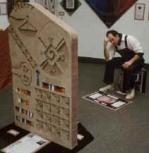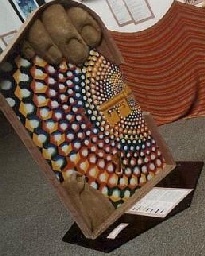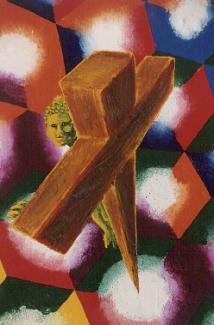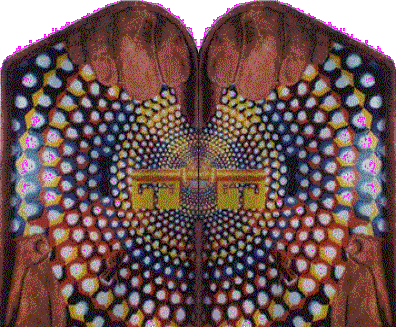 This
side is entitled Thinker's Vision, for its simulated
stone composition is similar to what Auguste Rodin's The Thinker
might perceive in the peripheral vision of his left eye: the large
fingers of the right hand resting on the forehead (unseen) in the
upper right foreground, and the left hand resting on the knee in
the lower left
This
side is entitled Thinker's Vision, for its simulated
stone composition is similar to what Auguste Rodin's The Thinker
might perceive in the peripheral vision of his left eye: the large
fingers of the right hand resting on the forehead (unseen) in the
upper right foreground, and the left hand resting on the knee in
the lower left semi-foreground. In the middle ground nearby, there is a small figure
of a Buddha upon a cross, looking up at the viewer over His left
shoulder. He represents an independent thinker who has achieved
a state of perfect enlightenment, capable of infinite and harmonious
expansion on both the horizontal and vertical planes. The cross
is rooted in a tri-colored hexagon: red and violet are the extremes
of the spectrum, and green - compounded of blue and yellow, Heaven
and Earth combined, forms the mystic color; also combining the cold
blue light of the intellect with the emotional warmth of the yellow
sun to produce the wisdom of equality, hope, renewal of life, and
resurrection.
semi-foreground. In the middle ground nearby, there is a small figure
of a Buddha upon a cross, looking up at the viewer over His left
shoulder. He represents an independent thinker who has achieved
a state of perfect enlightenment, capable of infinite and harmonious
expansion on both the horizontal and vertical planes. The cross
is rooted in a tri-colored hexagon: red and violet are the extremes
of the spectrum, and green - compounded of blue and yellow, Heaven
and Earth combined, forms the mystic color; also combining the cold
blue light of the intellect with the emotional warmth of the yellow
sun to produce the wisdom of equality, hope, renewal of life, and
resurrection.
 Here
each hexagon represents a trinity of cells: monastic, biological,
and the honeybee comb. They all possess a binary triplicate coloring
system that emanates from a central point behind the shaft of the
key on the right. The hexagons are arranged as seven sets of four
in each progressive semicircular band: four referring to the original
four elements, seven referring to the number of components within
the three series (color, harmonics, and chakras), and the total
of twenty-eight referring to the number of days in both the lunar
and menstrual cycles. Here a color from each of the three series
claims two inner surfaces within each hexagon: the color of the
two surfaces emanating from the central point corresponds to the
color series (red-passion, orange-splendor, yellow-intuition, green-renewal,
blue-truth, indigo-wisdom, and violet-knowledge), the color of the
two surfaces facing counter clockwise represents the harmonic series
(red-C, orange-D, violet-E, yellow-F, green-G, indigo-A, and blue-B),
and the color of the two surfaces facing clockwise represents the
chakra series (red-root, green-sacral, orange-solar plexus, blue-heart,
indigo-throat, yellow-third eye, and violet-crown).
Here
each hexagon represents a trinity of cells: monastic, biological,
and the honeybee comb. They all possess a binary triplicate coloring
system that emanates from a central point behind the shaft of the
key on the right. The hexagons are arranged as seven sets of four
in each progressive semicircular band: four referring to the original
four elements, seven referring to the number of components within
the three series (color, harmonics, and chakras), and the total
of twenty-eight referring to the number of days in both the lunar
and menstrual cycles. Here a color from each of the three series
claims two inner surfaces within each hexagon: the color of the
two surfaces emanating from the central point corresponds to the
color series (red-passion, orange-splendor, yellow-intuition, green-renewal,
blue-truth, indigo-wisdom, and violet-knowledge), the color of the
two surfaces facing counter clockwise represents the harmonic series
(red-C, orange-D, violet-E, yellow-F, green-G, indigo-A, and blue-B),
and the color of the two surfaces facing clockwise represents the
chakra series (red-root, green-sacral, orange-solar plexus, blue-heart,
indigo-throat, yellow-third eye, and violet-crown).
Incidentally, the cell beneath
the crucifix was the first to be painted with its three colors.
From that one point the entire pattern fell into place, repeating
every seven bands. By surprising coincidence, all three series synchronized
within four blue cells at the center of the composition near the
end of the key's golden bit. It created an opportunity to further
emphasize this intriguing phenomenon by sculpting a keyhole within
three of these monochromatic cells.
Amazingly, the central portion
of the obverse ideally accommodated the keyhole into its composition.
After pondering the colorful relationships the cells possess around
their nuclei, the viewer may consider the colorful trinities of
contact connecting all the hexagons, alluding to the fifth element.
The viewer might also ponder the possibility of placing this composition
to a mirror at a right angle to experience a colorful resonating
tunnel vision.


